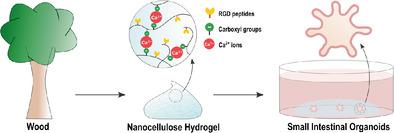Our official English website, www.x-mol.net, welcomes your feedback! (Note: you will need to create a separate account there.)
Engineered Plant‐Based Nanocellulose Hydrogel for Small Intestinal Organoid Growth
Advanced Science ( IF 15.1 ) Pub Date : 2020-11-20 , DOI: 10.1002/advs.202002135 Rodrigo Curvello 1 , Genevieve Kerr 2 , Diana J. Micati 2 , Wing Hei Chan 2 , Vikram S. Raghuwanshi 1 , Joseph Rosenbluh 3 , Helen E. Abud 2 , Gil Garnier 1
Advanced Science ( IF 15.1 ) Pub Date : 2020-11-20 , DOI: 10.1002/advs.202002135 Rodrigo Curvello 1 , Genevieve Kerr 2 , Diana J. Micati 2 , Wing Hei Chan 2 , Vikram S. Raghuwanshi 1 , Joseph Rosenbluh 3 , Helen E. Abud 2 , Gil Garnier 1
Affiliation

|
Organoids are three‐dimensional self‐renewing and organizing clusters of cells that recapitulate the behavior and functionality of developed organs. Referred to as “organs in a dish,” organoids are invaluable biological models for disease modeling or drug screening. Currently, organoid culture commonly relies on an expensive and undefined tumor‐derived reconstituted basal membrane which hinders its application in high‐throughput screening, regenerative medicine, and diagnostics. Here, we introduce a novel engineered plant‐based nanocellulose hydrogel is introduced as a well‐defined and low‐cost matrix that supports organoid growth. Gels containing 0.1% nanocellulose fibers (99.9% water) are ionically crosslinked and present mechanical properties similar to the standard animal‐based matrix. The regulation of the osmotic pressure is performed by a salt‐free strategy, offering conditions for cell survival and proliferation. Cellulose nanofibers are functionalized with fibronectin‐derived adhesive sites to provide the required microenvironment for small intestinal organoid growth and budding. Comparative transcriptomic profiling reveals a good correlation with transcriptome‐wide gene expression pattern between organoids cultured in both materials, while differences are observed in stem cells‐specific marker genes. These hydrogels are tunable and can be combined with laminin‐1 and supplemented with insulin‐like growth factor (IGF‐1) to optimize the culture conditions. Nanocellulose hydrogel emerges as a promising matrix for the growth of organoids.
中文翻译:

工程化的植物基纳米纤维素水凝胶可促进小肠类器官生长
类器官是三维的自我更新和组织的细胞簇,概述了发达器官的行为和功能。类器官被称为“菜中的器官”,是用于疾病建模或药物筛选的宝贵生物学模型。目前,类器官培养通常依赖于昂贵且不确定的肿瘤来源的重组基膜,这阻碍了其在高通量筛选,再生医学和诊断中的应用。在这里,我们介绍了一种新颖的,基于植物的工程化纳米纤维素水凝胶,它是定义明确且低成本的基质,可支持类器官生长。含有0.1%纳米纤维素纤维(99.9%的水)的凝胶经过离子交联,其机械性能与基于动物的标准基质相似。渗透压的调节采用无盐策略,为细胞存活和增殖提供条件。纤维素纳米纤维通过纤连蛋白衍生的粘合位点进行功能化,为小肠类器官的生长和萌芽提供所需的微环境。比较的转录组谱分析显示,两种材料中培养的类器官之间的转录组全基因表达模式具有良好的相关性,而在干细胞特异性标记基因中观察到差异。这些水凝胶是可调的,可以与层粘连蛋白-1结合使用,并补充胰岛素样生长因子(IGF-1)以优化培养条件。纳米纤维素水凝胶成为类器官生长的有希望的基质。纤维素纳米纤维通过纤连蛋白衍生的粘合位点进行功能化,为小肠类器官的生长和萌芽提供所需的微环境。比较的转录组谱分析显示,两种材料中培养的类器官之间的转录组全基因表达模式具有良好的相关性,而在干细胞特异性标记基因中观察到差异。这些水凝胶是可调的,可以与层粘连蛋白-1结合使用,并补充胰岛素样生长因子(IGF-1)以优化培养条件。纳米纤维素水凝胶成为类器官生长的有希望的基质。纤维素纳米纤维通过纤连蛋白衍生的粘合位点进行功能化,为小肠类器官的生长和萌芽提供所需的微环境。比较的转录组谱分析显示,两种材料中培养的类器官之间的转录组全基因表达模式具有良好的相关性,而在干细胞特异性标记基因中观察到差异。这些水凝胶是可调的,可以与层粘连蛋白-1结合使用,并补充胰岛素样生长因子(IGF-1)以优化培养条件。纳米纤维素水凝胶成为类器官生长的有希望的基质。比较的转录组谱分析显示,两种材料中培养的类器官之间的转录组全基因表达模式具有良好的相关性,而在干细胞特异性标记基因中观察到差异。这些水凝胶是可调的,可以与层粘连蛋白-1结合使用,并补充胰岛素样生长因子(IGF-1)以优化培养条件。纳米纤维素水凝胶成为类器官生长的有希望的基质。比较的转录组谱分析显示,两种材料中培养的类器官之间的转录组全基因表达模式具有良好的相关性,而在干细胞特异性标记基因中观察到差异。这些水凝胶是可调的,可以与层粘连蛋白-1结合使用,并补充胰岛素样生长因子(IGF-1)以优化培养条件。纳米纤维素水凝胶成为类器官生长的有希望的基质。
更新日期:2021-01-07
中文翻译:

工程化的植物基纳米纤维素水凝胶可促进小肠类器官生长
类器官是三维的自我更新和组织的细胞簇,概述了发达器官的行为和功能。类器官被称为“菜中的器官”,是用于疾病建模或药物筛选的宝贵生物学模型。目前,类器官培养通常依赖于昂贵且不确定的肿瘤来源的重组基膜,这阻碍了其在高通量筛选,再生医学和诊断中的应用。在这里,我们介绍了一种新颖的,基于植物的工程化纳米纤维素水凝胶,它是定义明确且低成本的基质,可支持类器官生长。含有0.1%纳米纤维素纤维(99.9%的水)的凝胶经过离子交联,其机械性能与基于动物的标准基质相似。渗透压的调节采用无盐策略,为细胞存活和增殖提供条件。纤维素纳米纤维通过纤连蛋白衍生的粘合位点进行功能化,为小肠类器官的生长和萌芽提供所需的微环境。比较的转录组谱分析显示,两种材料中培养的类器官之间的转录组全基因表达模式具有良好的相关性,而在干细胞特异性标记基因中观察到差异。这些水凝胶是可调的,可以与层粘连蛋白-1结合使用,并补充胰岛素样生长因子(IGF-1)以优化培养条件。纳米纤维素水凝胶成为类器官生长的有希望的基质。纤维素纳米纤维通过纤连蛋白衍生的粘合位点进行功能化,为小肠类器官的生长和萌芽提供所需的微环境。比较的转录组谱分析显示,两种材料中培养的类器官之间的转录组全基因表达模式具有良好的相关性,而在干细胞特异性标记基因中观察到差异。这些水凝胶是可调的,可以与层粘连蛋白-1结合使用,并补充胰岛素样生长因子(IGF-1)以优化培养条件。纳米纤维素水凝胶成为类器官生长的有希望的基质。纤维素纳米纤维通过纤连蛋白衍生的粘合位点进行功能化,为小肠类器官的生长和萌芽提供所需的微环境。比较的转录组谱分析显示,两种材料中培养的类器官之间的转录组全基因表达模式具有良好的相关性,而在干细胞特异性标记基因中观察到差异。这些水凝胶是可调的,可以与层粘连蛋白-1结合使用,并补充胰岛素样生长因子(IGF-1)以优化培养条件。纳米纤维素水凝胶成为类器官生长的有希望的基质。比较的转录组谱分析显示,两种材料中培养的类器官之间的转录组全基因表达模式具有良好的相关性,而在干细胞特异性标记基因中观察到差异。这些水凝胶是可调的,可以与层粘连蛋白-1结合使用,并补充胰岛素样生长因子(IGF-1)以优化培养条件。纳米纤维素水凝胶成为类器官生长的有希望的基质。比较的转录组谱分析显示,两种材料中培养的类器官之间的转录组全基因表达模式具有良好的相关性,而在干细胞特异性标记基因中观察到差异。这些水凝胶是可调的,可以与层粘连蛋白-1结合使用,并补充胰岛素样生长因子(IGF-1)以优化培养条件。纳米纤维素水凝胶成为类器官生长的有希望的基质。



























 京公网安备 11010802027423号
京公网安备 11010802027423号